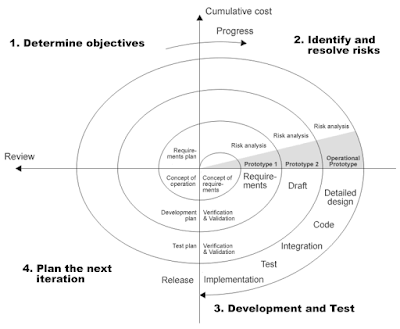Method of spiral model
The spiral model is a system development lifecycle (SDLC) approach used for managing risk which combines the iterative process model with waterfall model elements. Technology developers use the spiral model and are favoured for massive, costly and complex ventures. The number of loops varies according to each task and is often determined by the project manager.However, every Spiral loop is a step in the cycle of software design.
Figure 1: NAYAN .R.(2010). Software development life cycle model. Available from : https://www.researchgate.net/figure/Boehms-spiral-life-cycle-The-spiral-model-attempts-to-address-two-main-difficulties-of_fig4_220631422[Accessed on 12/02/2020]
The image of spiral model shown above is, the spiral radius that reflects project expense and the angular degree reflects the improvement achieved in the current process. Growing process begins with a design target and ends when the creator or customer checks the development. Every process may be divided into four quadrants that requires the recognition and awareness, risk mitigation, system construction, and output assessment of the programme.
Conclusion:
Despite the two model that have different aspect in the development of application, the waterfall model is easier to use when creating small project and if the project is short and to avoid an error or flaws you need to use agile model alongside the waterfall model to avoid the application breaking down. Spiral model is strong on it own, it is combination of waterfall model and iteration which can go on along term project as exspected.
Reference:
MARGANET R. (2019) Spiral Model. Available from: https://searchsoftwarequality.techtarget.com/definition/spiral-model [Accessed on 12/03/2020]
NAYAN .R.(2010). Software development life cycle model. Available from : https://www.researchgate.net/figure/Boehms-spiral-life-cycle-The-spiral-model-attempts-to-address-two-main-difficulties-of_fig4_220631422[Accessed on 12/02/2020]



Comments
Post a Comment